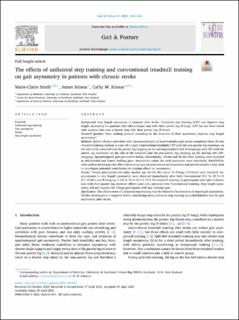| dc.contributor.author | Smith, M.-C. | |
| dc.contributor.author | Stinear, J. | |
| dc.contributor.author | Stinear, C. M. | |
| dc.date.accessioned | 2021-10-06T11:00:09Z | |
| dc.date.available | 2021-10-06T11:00:09Z | |
| dc.date.issued | 2021 | |
| dc.identifier.citation | Smith, M.-C., Stinear, J., & Stinear, C. M. (2021). The effects of unilateral step training and conventional treadmill training on gait asymmetry in patients with chronic stroke. Gait & Posture, 87, 156-162. | en_US |
| dc.identifier.uri | https://hdl.handle.net/11250/2788097 | |
| dc.description.abstract | Background
Step length asymmetry is common after stroke. Unilateral step training (UST) can improve step length asymmetry for patients who take a longer step with their paretic leg (P-long). UST has not been tested with patients who take a shorter step with their paretic leg (P-short).
Research question
Does training patients according to the direction of their asymmetry improve step length asymmetry?
Methods
Adults 18 years and older with asymmetrical gait at least 6 months post-stroke completed three 20 min treadmill training sessions at least 48 h apart: Conventional treadmill; UST with the non-paretic leg stationary on the side of the treadmill and the paretic leg stepping on the moving treadmill belt (P-stepping); and UST with the paretic leg stationary on the side of the treadmill and the non-paretic leg stepping on the moving belt (NP-stepping). Spatiotemporal gait parameters before, immediately, 10 min and 30 min after training were recorded at self-selected and fastest walking pace. Asymmetry values for each parameter were calculated. RmANOVAs were used to investigate the effects of training type on spatiotemporal parameters and paired-samples t-tests used to investigate potential contributors to training effects on asymmetry.
Results
Twenty participants (16 male, median age 65 (43–80) years; 11 P-long, 9 P-short) were included. Improvements in step length asymmetry were observed immediately after both Conventional (9.1 %; 95 % CI 2.7–15.4%) and P-stepping (11.6 %; 95 % CI 5.3–17.8 %) treadmill training in participants who take a shorter step with their paretic leg, however effects were only sustained after Conventional training. Step length asymmetry did not improve for P-long participants with any training type.
Significance
The effectiveness of unilateral step training may be related to the direction of step length asymmetry. Further investigation is required before considering using unilateral step training as a rehabilitation tool for gait asymmetry after stroke. | en_US |
| dc.publisher | Gait & Posture | en_US |
| dc.subject | unilateral step training | en_US |
| dc.subject | gait asymmetry | en_US |
| dc.subject | stroke | en_US |
| dc.subject | step length asymmetry | en_US |
| dc.subject | nevrologiske lidelser | en_US |
| dc.title | The effects of unilateral step training and conventional treadmill training on gait asymmetry in patients with chronic stroke | en_US |
| dc.type | Journal article | en_US |
| dc.source.pagenumber | 156-162 | en_US |
| dc.source.volume | 87 | en_US |
| dc.source.journal | Gait & Posture | en_US |
| dc.identifier.doi | https://doi.org/10.1016/j.gaitpost.2021.04.035 | |
| dc.description.localcode | måsjekkes | |
